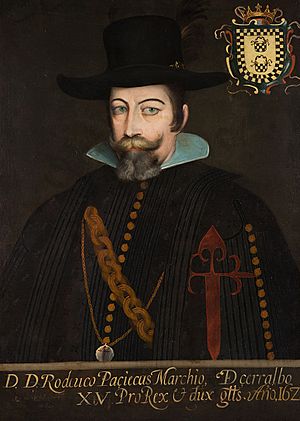Rodrigo Pacheco, 3rd Marquess of Cerralvo facts for kids
Rodrigo Pacheco y Osorio de Toledo, 3rd Marquess of Cerralvo, was an important Spanish nobleman. He served as a judge in Spain and later became the viceroy of New Spain, which is now Mexico. He was in charge from November 3, 1624, to September 16, 1635.
Contents
Early Life and Becoming Viceroy
Rodrigo Pacheco y Osorio was born in Spain around 1565. He was related to another important leader, Juan Antonio Pacheco. Rodrigo was known for his skills in the military. Because of his abilities, he was chosen to be a judge, called an inquisitor, in the city of Valladolid.
The King of Spain, Philip IV of Spain, had a big problem in New Spain. The previous viceroy, Diego Carrillo de Mendoza, 1st Marquess of Gelves, had caused a lot of trouble with the archbishop of Mexico. The king needed someone strong and fair to fix things. He chose Rodrigo Pacheco y Osorio to investigate what happened and take over the government. Rodrigo was given special instructions and great power to solve these problems.
Protecting New Spain from Threats
Rodrigo Pacheco arrived in Mexico City on November 3, 1624, and immediately began his work as viceroy. He had to quickly deal with some very serious challenges. Spain was fighting wars with France and the Dutch Republic.
Dutch Attacks on Spanish Ships
A fleet of Dutch ships was threatening Acapulco, an important port city on the Pacific coast. Rodrigo quickly worked to strengthen Acapulco's defenses.
Later, in December 1628, a Dutch admiral named Piet Hein captured a Spanish fleet. This happened in the waters between Florida and the Bahamas. This fleet was carrying a huge amount of money, mostly gold, and many valuable goods from New Spain back to Spain. This was a very big loss for Spain.
Pirate Raids and Fort Building
Dutch pirates, also called corsairs, attacked the city of Campeche in April 1633. However, 200 local soldiers, led by Captain Francisco Maldonado, managed to drive them away. But the pirates returned in August of the same year and attacked the city again.
To protect the northern parts of New Spain from attacks by Native American groups, Pacheco built a fort. This fort was called the presidio of Cerralvo, and it was located in what is now Nuevo León.
Solving Mexico City's Flood Problems
One of the biggest and longest-lasting problems for Mexico City was flooding. The city often got flooded from the 1500s all the way into the late 1800s.
Early Drainage Efforts
After a major flood in 1607, a huge project was started to drain water away from the city. This project involved digging open ditches and building tunnels. It was known as the Desagüe, which means "drainage" in Spanish. This was a very expensive project and required a lot of labor from Native American workers.
Rodrigo Pacheco y Osorio was worried that work on the dikes (walls to hold back water) and the drainage system had stopped. So, in 1626, he ordered that construction begin again. He also made sure the walls around the city were repaired and made stronger. He started some smaller projects to finish the plans of an engineer named Adrian Boot.
The Great Flood of 1629
In 1627, a river called the Río Cuautitlán broke through its dike. The water rose half a meter, flooding parts of the city. The city government asked the viceroy to build more drainage systems. But time passed with many discussions, and the water eventually went down on its own.
However, in 1629, Mexico City suffered its worst flood ever recorded. The Río Aculhuacán broke its dikes, and the entire city was flooded with water 1 to 2 meters deep. People had to use canoes to get around, and many families left the city for good. The rains kept falling, and the floodwaters did not go away. It's believed that about 30,000 people died, and many feared that the capital city might disappear completely. Some parts of the city stayed flooded for four years!
On May 19, 1630, the viceroy suggested moving the capital to Tacubaya, a nearby area on higher ground. But the city's leaders disagreed. They decided instead to restart the important engineering work. By the end of that year, an engineer named Enrico Martínez had restarted the drainage project. By 1632, the Huehuetoca canal was finally finished. Also, the Calzada de San Cristóbal, which was a road on top of a wall that acted as a dike around the city, was repaired.
Return to Spain and Later Life
Rodrigo Pacheco y Osorio managed many big public works projects, and a lot of money passed through his hands. When he returned to Spain in September 1635, he was a very wealthy man.
King Philip IV honored him greatly. He was made a royal advisor, a lord of the king's bedchamber, and a chief manager of the palace. Later, he even served as Spain's ambassador to Vienna. He passed away in Madrid in June 1652.
Images for kids
See also
 In Spanish: Rodrigo Pacheco y Osorio para niños
In Spanish: Rodrigo Pacheco y Osorio para niños



